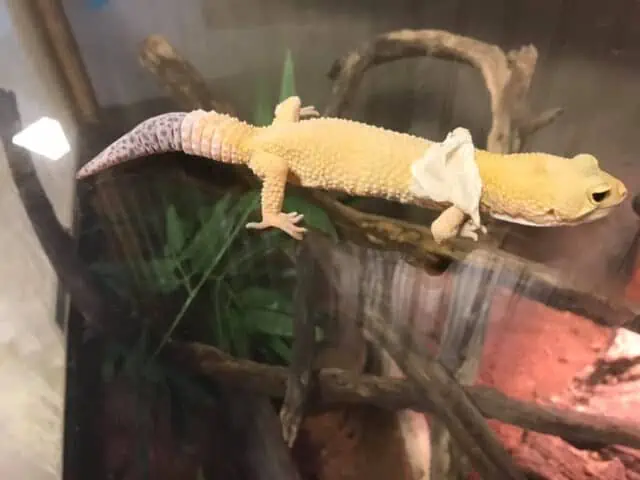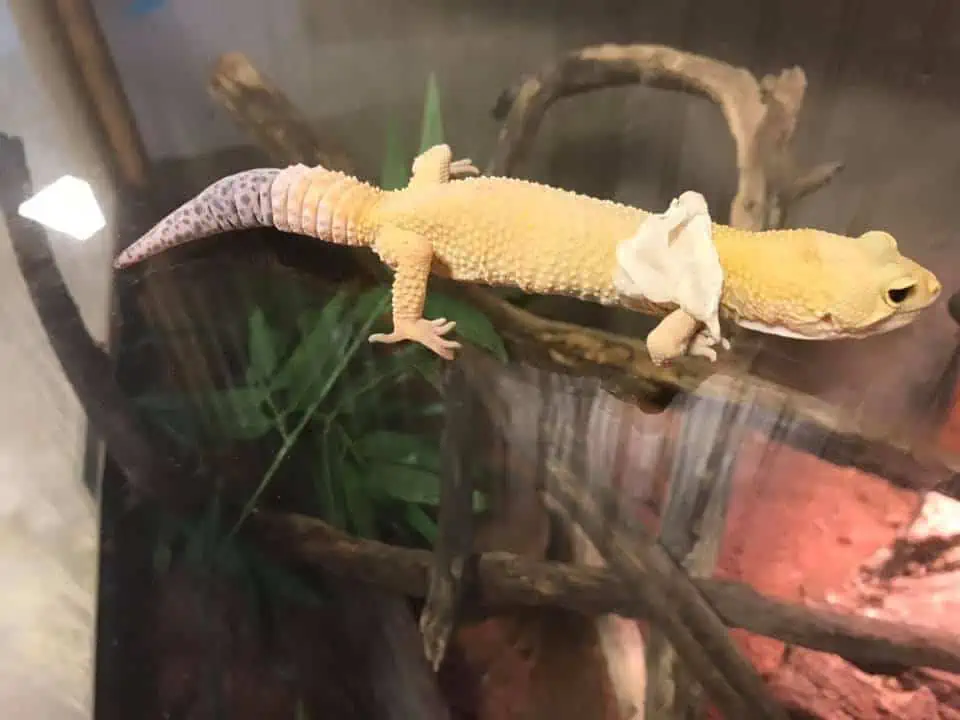Dysecdysis in leopard geckos is a condition where these captivating reptiles face difficulties during their shedding process. When not addressed promptly, it can lead to several complications.
What is Dysecdysis in Leopard Geckos?
Dysecdysis refers to the problematic shedding process in reptiles, particularly in leopard geckos. When a leopard gecko undergoes a regular shedding cycle, the old skin should come off easily, revealing fresh skin underneath. However, in cases of dysecdysis, this doesn’t happen seamlessly.
Why is it Important to Address Dysecdysis in Leopard Geckos?
Addressing dysecdysis in leopard geckos is of paramount importance due to the array of complications it can lead to. Firstly, when the old skin doesn’t shed properly, it can result in constriction, especially around delicate areas like toes, leading to reduced blood flow. Over time, this can cause tissue death and even loss of a body part.
Furthermore, these retained sheds can become breeding grounds for bacteria, leading to infections. In some instances, geckos with problematic sheds might exhibit signs of lethargy, meaning they become less active and more sluggish. This is a cause for concern, especially if you also notice a decreased appetite, as it can indicate underlying health issues tied to the shedding problem.
| Symptom | Cause | Solution |
|---|---|---|
| Constriction | Retained skin cutting off circulation | Immediate attention, possible soaking |
| Infection | Bacteria accumulation under old skin | Veterinary intervention |
| Lethargy | Discomfort from unshed skin | Monitor closely, ensure optimal habitat conditions |
| Decreased appetite | General health decline due to dysecdysis | Review diet, check for other symptoms |
If your gecko displays severe symptoms, such as profound lethargy or visible infections, it’s imperative to seek veterinary care immediately.
For milder cases where you notice a few pieces of stuck shed, a home remedy is to gently soak the gecko in lukewarm water. This can help soften and remove the retained skin. Always ensure the water is not too hot and monitor your gecko closely during the soak to prevent any distress.
Causes of Dysecdysis in Leopard Geckos

While leopard geckos, like other reptiles, naturally shed their skin, certain factors can interfere with this process, leading to dysecdysis. From dietary issues to infections and even parasites, a range of culprits can be behind this problematic shedding.
Poor Diet
A poor diet is one of the primary culprits behind many health issues in leopard geckos, including dysecdysis. When a gecko is not provided with the essential nutrients its body demands, it can’t function at its best. The skin might lose its elasticity and resilience, making shedding a tough ordeal.
Ensuring a diverse and nutritious menu for your gecko is essential. This means offering a wide variety of insects that themselves have been fed a calcium-rich diet. Prior to serving these insects to your gecko, it’s a good practice to dust them with calcium. This not only ensures that the gecko is getting its required calcium dose but also promotes overall well-being.
| Consequence of Poor Diet | Description |
|---|---|
| Chronic malnutrition | Prolonged lack of essential nutrients leading to a weakened immune system and increased vulnerability to diseases. |
| Hepatic lipidosis | A liver disease where excess fat accumulates in liver cells, affecting liver function and overall health. |
| Nutritional secondary hyperparathyroidism | A condition resulting from calcium deficiency, leading to weakened bones and potential fractures. |
Neglecting the diet of leopard geckos can lead to severe health conditions. Chronic malnutrition can make them susceptible to various ailments due to a weakened immune system. Hepatic lipidosis is another concern, a liver condition arising from continuous poor nutrition.
Furthermore, nutritional secondary hyperparathyroidism can be a direct consequence of calcium deficiency, a condition that weakens the gecko’s bones, making them prone to fractures.
Metabolic Bone Disease
Metabolic Bone Disease (MBD) is a severe health condition that can afflict leopard geckos. Rooted in nutritional imbalances, primarily calcium deficiency and vitamin D3 deficiency, MBD affects the bone health of these reptiles. The bones, deprived of essential nutrients, weaken over time, leading to various complications including bone deformities.
Symptoms indicative of MBD in leopard geckos include:
- Limping or difficulty in movement
- Swollen or soft jaw (often termed “rubber jaw”)
- Curved or twisted spine
- Softened or easily fractured bones
- Tremors or twitching
| Symptom of MBD | Description |
|---|---|
| Limping | Difficulty in walking or unnatural gait due to weak bones. |
| Soft jaw | A jaw that feels rubbery and doesn’t close properly, often making feeding challenging. |
| Curved spine | Abnormal curvature of the spine resulting from weakened vertebrae. |
| Tremors | Muscle twitches or spasms, especially evident in legs. |
Prevention is better than cure, and with MBD, this holds true. To prevent MBD:
- Ensure a diet rich in calcium and vitamin D3 for your gecko.
- Regularly dust feeder insects with a quality calcium and vitamin D3 supplement.
- Provide adequate UVB lighting, which helps in vitamin D3 synthesis and calcium absorption.
In cases where MBD is diagnosed, treatment options include:
- Immediate dietary correction, focusing on calcium and vitamin D3.
- Increased UVB exposure.
- Veterinary consultations for potential calcium injections or oral supplements.
Bacterial Infection
Bacterial infections are a concerning factor that can lead to dysecdysis in leopard geckos. These infections often penetrate the skin, especially if there are open wounds or if the gecko is undergoing a problematic shed. Once established, these infections can manifest in various forms, leading to a host of issues, with dysecdysis being one of the most evident.
Common signs and symptoms of bacterial infections in leopard geckos include:
- Redness or inflammation around the affected area.
- Pus or discharge from wounds or affected areas.
- Unusual odor emanating from the skin or affected regions.
- Lethargy or reduced activity.
- Loss of appetite.
| Sign of Bacterial Infection | Description |
|---|---|
| Redness | Inflamed skin or areas indicating a potential infection site. |
| Pus | Yellowish-white fluid accumulation, a clear indication of an infection. |
| Unusual odor | Foul-smelling scent, often indicative of bacterial presence. |
| Lethargy | Reduced activity levels hinting at discomfort or illness. |
Addressing bacterial infections promptly is of utmost importance. Left untreated, these infections can delve deeper, affecting internal organs, leading to septicemia, and in severe cases, can be fatal. Quick intervention not only alleviates pain and discomfort but also prevents complications that might require intensive care.
Treatment options for bacterial infections in leopard geckos encompass:
- Topical antibiotics: Directly applied to the affected area to combat localized infections.
- Systemic antibiotics: Oral or injectable antibiotics prescribed by a veterinarian to treat widespread or severe infections.
- Regular cleaning: Ensuring the habitat is clean and free from harmful bacteria can aid in faster recovery and prevent re-infections.
External Parasites
External parasites are pesky adversaries for leopard geckos. These critters not only cause immense discomfort but can also lead to serious complications like dysecdysis. One alarming sign of such parasitic infestation is the presence of thin, string-like worms in the conjunctival sac of the gecko’s eyes. It’s a sight that can unsettle any gecko enthusiast.
The infestation often starts subtly. One major route of introduction is through the inappropriate management of retained sheds. A gecko’s eyelids are uniquely designed, and if there are difficulties during skin shedding, parasites can find an entry point. Additionally, contaminated substrates, food, or even new reptiles introduced into the environment without proper quarantine can all be potential sources of these pests.
| Potential Sources of Parasite Introduction | Description |
|---|---|
| Retained sheds | Parasites can find an entry point if the gecko faces skin shedding issues. |
| Contaminated food or substrate | Introducing pests from outside sources can bring parasites. |
| New reptiles | Without proper quarantine, new reptiles can introduce external parasites. |
To keep your leopard gecko safe from these external parasites, consider the following preventive measures:
- Regular parasite treatments: Consult a veterinarian about suitable treatments that can be administered periodically to keep parasites at bay.
- Proper husbandry procedures: Ensure that the gecko’s habitat is clean and maintained appropriately. This includes changing substrates, sanitizing the habitat, and ensuring no fecal matter accumulates.
- Quarantine new reptiles: Before introducing a new reptile to the same environment as your leopard gecko, ensure they are quarantined and checked for parasites.
- Hygienic food sources: Ensure that the food you provide is from reputable sources and is not contaminated.
Internal Parasites
The health of a leopard gecko is not just determined by what’s visible on the outside but also by what lurks within. Internal parasites are one such hidden threat. Just as external parasites can be alarming, internal parasites have their own set of challenges, with the presence of thin, string-type worms in the conjunctival sac of the eyes being a telltale sign.
| Internal Parasites Signs in Leopard Geckos | Description |
|---|---|
| String-type worms | Often found in the conjunctival sac of the eyes, these worms are a clear indication of internal parasitic infection. |
| Digestive disturbances | Unexplained weight loss, unusual droppings, or appetite changes can also hint at internal parasites. |
| Behavioral changes | Lethargy, decreased activity, or sudden aggressiveness might be linked to discomfort caused by parasites. |
The pathogenesis of these infections is multifaceted. Trauma to the gecko’s body can be an entryway for these pests, especially in conditions like perforated ulcers. Foreign bodies, such as non-digestible substrates or contaminated food, can introduce parasites internally.
Another cause, similar to the external parasites, is the inappropriate management of retained shed. If there’s a lapse in shed management, secondary infections may arise, granting internal parasites an opportunity to invade.
Prevention and Treatment of Dysecdysis in Leopard Geckos
When it comes to the well-being of leopard geckos, prevention is as crucial as treatment. Addressing dysecdysis early can circumvent a myriad of health challenges that can be distressing for both the gecko and its caregiver.
Proper Husbandry Procedures
Proper husbandry procedures are the cornerstone of ensuring optimal health for leopard geckos, especially when it comes to preventing and addressing dysecdysis. Hygiene and sanitation play a pivotal role in this. Imagine how our homes would be if we didn’t clean for a month; the same applies to our reptilian friends.
Daily spot cleaning ensures that waste and uneaten food don’t become breeding grounds for harmful bacteria. Beyond this, monthly deep cleaning and disinfection remove any lurking pathogens, ensuring a pristine environment for the gecko.
| Husbandry Best Practices | Purpose |
|---|---|
| Daily Spot Cleaning | Removes daily waste and uneaten food, preventing bacterial growth. |
| Monthly Deep Cleaning | Comprehensive cleaning to eliminate pathogens and maintain hygiene. |
| Use of Latex Gloves | Ensures minimal direct contact, reducing the risk of contamination. |
Speaking of contact, while our urge to frequently handle these fascinating creatures is understandable, it’s essential to do so with care. Using latex gloves not only protects the gecko from any contaminants on our hands but also safeguards us from potential allergens or irritants from the gecko. Ensuring that you’re using the right equipment is always a good idea. Not doing this can result in accidents such as thermal burns and issues with shedding, among other things.
In the end, I’d recommend that you always keep an eye out on your little buddy. Even things like getting upside down all the time can signal a serious condition, not to mention things like tail drops. Learn about what makes him tick, so you can spot these signs.





